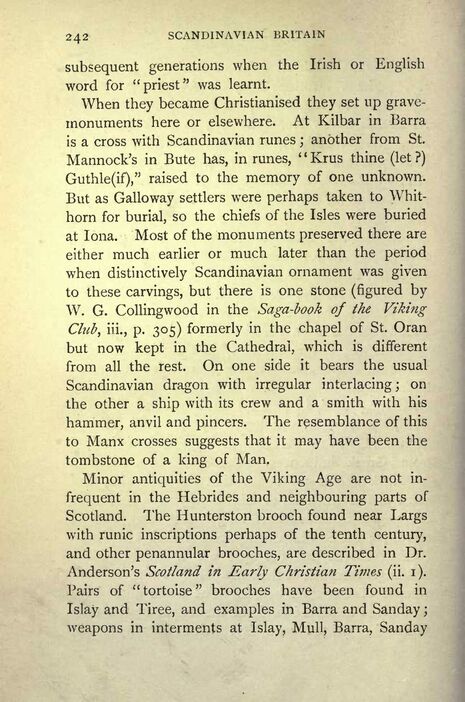
Full resolution (JPEG) - On this page / på denna sida - Scandinavian Britain - III. The Norse Settlements - 5. Man and the Isles

<< prev. page << föreg. sida << >> nästa sida >> next page >>
Below is the raw OCR text
from the above scanned image.
Do you see an error? Proofread the page now!
Här nedan syns maskintolkade texten från faksimilbilden ovan.
Ser du något fel? Korrekturläs sidan nu!
This page has been proofread at least once.
(diff)
(history)
Denna sida har korrekturlästs minst en gång.
(skillnad)
(historik)
subsequent generations when the Irish or English
word for "priest" was learnt.
When they became Christianised they set up grave-monuments
here or elsewhere. At Kilbar in Barra
is a cross with Scandinavian runes ; another from St.
Mannock’s in Bute has, in runes, "Krus thine (let?)
Guthle(if)," raised to the memory of one unknown.
But as Galloway settlers were perhaps taken to Whithorn
for burial, so the chiefs of the Isles were buried
at lona. Most of the monuments preserved there are
either much earlier or much later than the period
when distinctively Scandinavian ornament was given
to these carvings, but there is one stone (figured by
W. G. Collingwood in the Saga-book of the Viking
Club, iii., p. 305) formerly in the chapel of St. Oran
but now kept in the Cathedral, which is different
from all the rest. On one side it bears the usual
Scandinavian dragon with irregular interlacing; on
the other a ship with its crew and a smith with his
hammer, anvil and pincers. The resemblance of this
to Manx crosses suggests that it may have been the
tombstone of a king of Man.
Minor antiquities of the Viking Age are not infrequent
in the Hebrides and neighbouring parts of
Scotland. The Hunterston brooch found near Largs
with runic inscriptions perhaps of the tenth century,
and other penannular brooches, are described in Dr.
Anderson’s Scotland in Early Christian Times (ii. 1).
Pairs of "tortoise" brooches have been found in
Islay and Tiree, and examples in Barra and Sanday ;
weapons in interments at Islay, Mull, Barra, Sanday
<< prev. page << föreg. sida << >> nästa sida >> next page >>